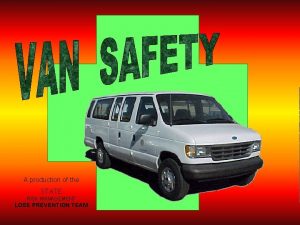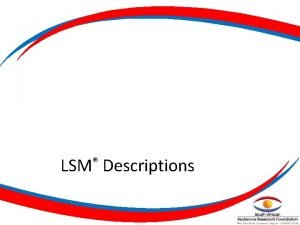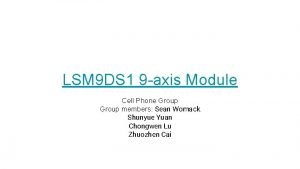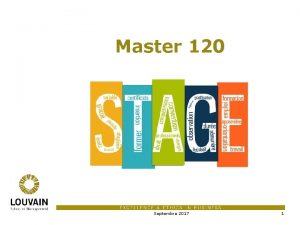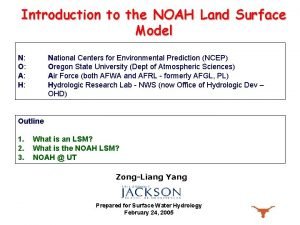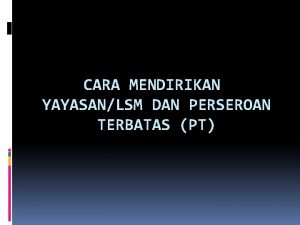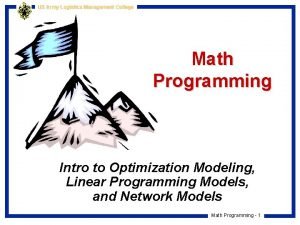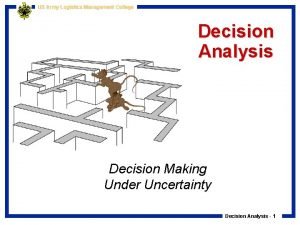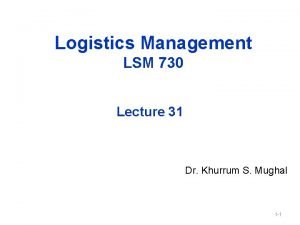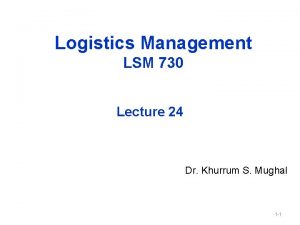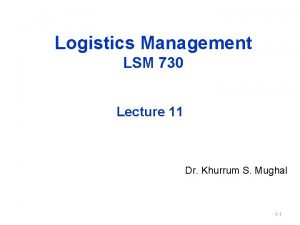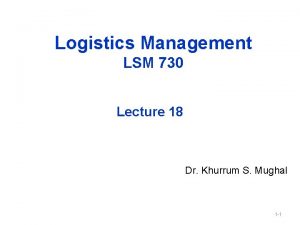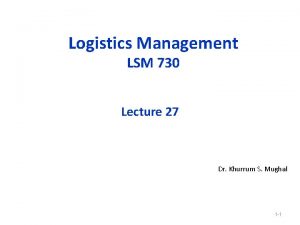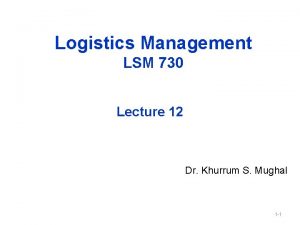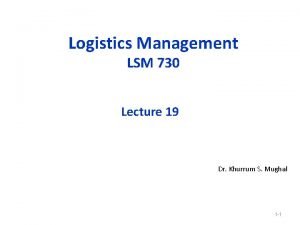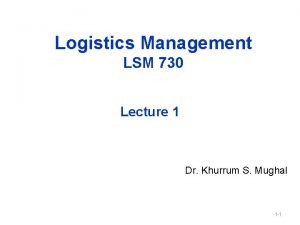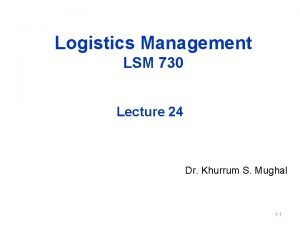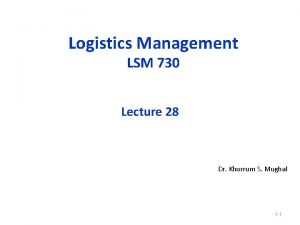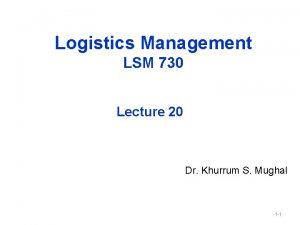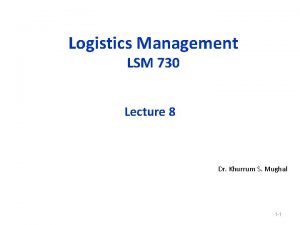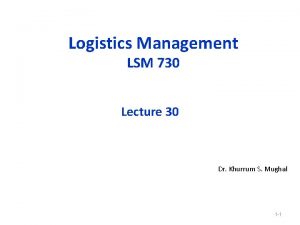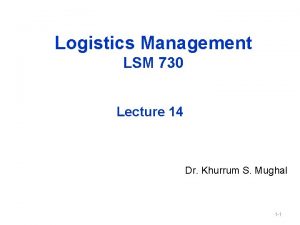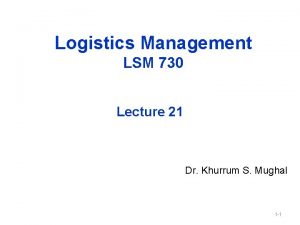Logistics Management LSM 730 Lecture 10 Dr Khurrum
















- Slides: 16

Logistics Management LSM 730 Lecture 10 Dr. Khurrum S. Mughal 1 -1

The Logistics/Supply Chain Product “Logistics/Supply Chain managers are ‘owners’ of the product-flow process from raw material sources to final consumers, not activity administrators. ” 3 -2

CONTROLLING Transport Strategy • Transport fundamentals • Transport decisions ORGANIZING Inventory Strategy • Forecasting • Inventory decisions • Purchasing and supply Customer scheduling decisions service goals • Storage fundamentals The product • Storage decisions • Logistics service • Ord. proc. & info. sys. PLANNING Product in the Planning Triangle Location Strategy • Location decisions • The network planning process 3 -3

Nature of the Product • Product classification – Consumer Products • Convenience goods • Shopping goods • Specialty goods – Industrial goods 1 -4

Nature of the Product • Product classification – Consumer Products • Convenience Products – – Purchased Frequently with little comparative shopping Distributed through multiple outlets High distribution costs justified by increased sales Example: vending machines for coca-cola 1 -5

Nature of the Product • Product classification – Consumer Products • Shopping Products – – – Consumers seek and compare Comparing quality, price and performance Few outlets to be maintained Distribution costs are lower Examples: Furniture, Medical Services, Automobiles etc 1 -6

Nature of the Product • Product classification – Consumer Products • Specialty Products – Buyers expend substantial effort – Buyers wait significant amount of time to get the particular product – Distribution is centralized – Lowest physical distribution costs – Examples: Consultancy Service, Musical Instruments for professional musicians 1 -7

Nature of the Product • Product classification – Industrial Products • Raw Material that is part of finishes goods • Machinery and equipment that is used for production process • Goods not directly involved like business services, and office Supplies 1 -8

Sales volume Product Life-Cycle Curve Introduction Growth Maturity Decline Time 3 -9

Product Life-Cycle Curve • Introductory Stage – Sales are not high – Cautious inventory and distribution strategies • Growth Stage – Huge growth after product acceptance – Not history of sales to manage inventory and distribution 1 -10

Product Life-Cycle Curve • Maturity Stage – Stable sales – Huge distribution, many stocking points – Sound forecasts • Decline Stage – Stocking points reduced to centralized distribution 1 -11

Nature of the Product 80% of Firm’s sales are generated by 20% of the product line items - Difference in inventory and distribution 3 -12

ABC Classification for 14 Products Product Number D-204 D-212 Product Rank by a Sales 1 2 Monthly Sales (000 s) $5, 056 3, 424 Cumulative An ABC Percent of Classifib c Total Sales Total Items cation 36. 2% 7. 1% 60. 7 14. 3 A D-185 -0 D-191 D-192 D-193 D-179 -0 3 4 5 6 7 1, 052 893 843 727 451 68. 3 74. 6 80. 7 85. 7 89. 1 21. 4 28. 6 35. 7 42. 9 50. 0 D-195 D-196 D-186 -0 D-198 -0 D-199 D-200 D-205 8 9 10 11 12 13 14 412 214 205 188 172 170 159 $13, 966 91. 9 93. 6 95. 1 96. 4 97. 6 98. 7 100. 0 57. 1 64. 3 71. 4 78. 6 85. 7 92. 9 100. 0 B C 3 -5

Cumulative 80 -20 Curve 100 90 Total sales (%) 80 70 60 50 40 30 A items 20 B items C items 10 0 0 20 40 60 Total items (%) 80 100 3 -6

Nature of the Product (Cont’d) Example Suppose that in an inventory of 10 items, 15% of the items account for 80% of the sales volume. The total sales of all 10 items is $90, 000 per year. How much inventory can be expected if turnover for A items = 8, B items = 5, and C items = 2? First, find A. A= . 15(1 -. 80) = 0. 0462. 80 -. 15 Then, using A = 0. 0462 and the first item (1/10), we project the sales volume to be: Y= (1 +. 0462). 10 = 0. 7156, or 71. 6% of the sales. 0462 +. 10 Projected Cumulative Sales 0. 716(90, 000) = $64, 440 Turnover Total sales The inventory for this item is expected to be 0. 716(90, 000)/8 = $8, 055. Continue for the remaining items and generate the following table. 3 -15

Example (Cont’d) Projected Item Cumulative cumulative (X) item sales no. fraction 1. 10. 716 2. 20. 850 3. 30. 907 4. 40. 938 5. 50. 958 6. 60. 971 7. 70. 981 8. 80. 989 9. 90. 995 10 1. 000 5 Projected cumulative sales (Y) $64, 440 76, 500 81, 630 84, 420 86, 220 87, 390 88, 290 89, 010 89, 550 90, 000 Projected Turnover Average item sales ratio inventory $64, 440 8: 1 $8, 055 A 12, 060 8: 1 1, 508 6, 630 5: 1 1, 326 B 2, 790 5: 1 558 1, 800 5: 1 360 1, 170 2: 1 585 900 2: 1 450 C 720 2: 1 360 540 2: 1 270 450 2: 1 225 $90, 000 $13, 697 3 -8
 Ieee 730
Ieee 730 Trimble sps 730
Trimble sps 730 256 en yakın onluğa yuvarlama
256 en yakın onluğa yuvarlama Ars 28-730
Ars 28-730 170 f a c
170 f a c Arlon 25fr
Arlon 25fr Lsm groups 1-10
Lsm groups 1-10 Lsm groups
Lsm groups 9dsmmwikhpi -site:youtube.com
9dsmmwikhpi -site:youtube.com Lsm framework
Lsm framework Convention de stage lsm
Convention de stage lsm Lsm
Lsm Cara mendirikan lsm
Cara mendirikan lsm Open source security
Open source security 01:640:244 lecture notes - lecture 15: plat, idah, farad
01:640:244 lecture notes - lecture 15: plat, idah, farad Army logistics management college
Army logistics management college Army logistics management college
Army logistics management college



